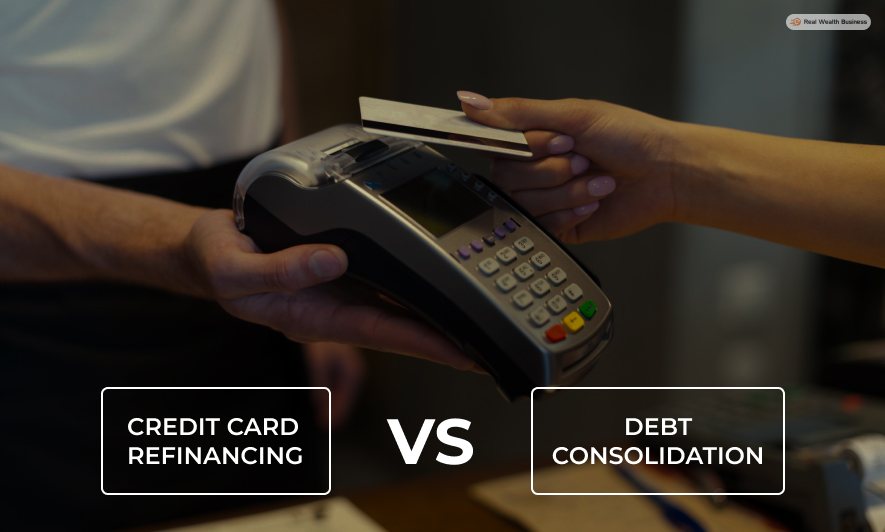Credit Card Refinancing Vs Debt Consolidation: Pay Off Debt Fast!
by Mashum Mollah Finance 17 October 2024

Credit card debt can be overwhelming to manage; that is especially true in the case of multiple cards – all with high balances. You are even more overwhelmed when they have different interest rates. That is when two options may seem feasible – credit card refinancing vs debt consolidation.
These two strategies help simplify the payments by reducing interest. However, they work differently. Nevertheless, both suit different financial situations quite well.
The following article describes the key differences between the strategies, discussing their pros and cons, and investigating how to choose the best of the two. As per financial forecasting, these two strategies are great for anyone looking to improve their finances.
Credit Card Refinancing Vs Debt Consolidation – What Do They Mean?

Credit card refinancing is a typical method of transferring one or more credit card/s balances to a new one with a lower interest rate. The process is often known as balance transfer, as many credit card companies offer unique balance transfer credit cards with 0% APR for a limited time.
APR, or Annual Percentage Rate, is the total yearly cost (interest and fees) of borrowing money. It is a critical factor in determining the price of a credit card or loan.
Credit card refinancing aims to use a lower interest rate to save money on interest payments. This is while you work to pay the debt as quickly as possible. The 0% APR is often an introductory offer with a set period.
These offers usually last for 12 to 18 months, after which the interest rates can increase to a higher rate, which is essential to pay off the balance. It is always wise to do this within the introductory period.
How Does Credit Card Refinancing Work?

Credit refinancing works in the following manner:
Step 1: You Choose A Balance Transfer Card
The first step in the former strategy of credit card refinancing vs debt consolidation is choosing credit card companies that offer the option of balance transfer. Preferably Especially those with 0% APR introductory periods.
You must also ensure that all the terms, such as the promotional rates period, are clear to you. It would help if you also inquired about the interest rates after the promotional period ends.
Step 2: Balance Transfer
Once the new card is approved, transfer the balances from the existing high-interest credit cards to it. Some cards may allow you to transfer balances from multiple cards.
Step 3: Pay off the Debt!
As advised, try to pay off as much debt as possible before the promotional period ends. You must make regular payments to reduce the balance and pay off the entire balance before the 0% APR period ends.
Step 4: Avoid New Debt
You must avoid new debt as it is one of the critical factors in successful credit card refinancing. When you want to avoid this situation, you must stay away from racking up new debt.
This will help you stay debt-free even after paying off the balance transfer. When choosing between wealth management vs investment banking, both these strategies will support the former.
Pros of Credit Card Refinancing
Here are the pros of credit card refinancing:
- You get lower interest rates or even 0% with APR. This strategy can save hundreds or thousands of dollars in interest payments with low- or 0% interest rates.
- The high potential of fast debt payoff is guaranteed. With this strategy, you can quickly reduce your credit card balances within the promotional period. This is because you’ll be able to make payments and avoid accumulating new debt diligently.
- It offers simplified payments as you consolidate balances from multiple cards into one. This allows you to facilitate payments by reducing them to one monthly bill
Cons of Credit Card Refinancing
These are the disadvantages of credit card refinancing vs debt consolidation:
- The promotional period is temporary, which makes it challenging to enjoy reduced interest rates. Despite helping you pay off the debt sooner, there can be a chunk of the balance that you pay off at higher interest rates. After 12 to 18 months (about 1 and a half years), you may have to pay off the debt at 20% or higher interest rates – that’s undoubtedly tough
- There are balance transfer fees that you may have to pay 3% to 5% of the amount that you transfer. So naturally, this may be a problematic amount if you are transferring a large amount
- You also need a good credit score to avail yourself of the transfer cards. You may lose out on this opportunity if your credit score is low, as you will not qualify for it!
What is Debt Consolidation?

In the debate of credit card refinancing vs debt consolidation, the latter is now the time to discuss. Debt consolidation, as you may have a slight idea from the name, is combining multiple debts (including credit cards?) into a single loan.
Cherry on the top? There’s a fixed interest rate! This strategy aims to streamline the debt repayment in a way that consolidates every amount into one monthly payment. This is exciting because you may even have to make that single payment with a lower interest rate than what is already being paid.
Debt consolidation is most common through personal loans; however, some people may even use home equity loans or lines of credit – HELOCs. A personal loan used for debt consolidation usually comes with a fixed interest rate, which can have a set repayment term. This term ranges from three to seven years.
How Does Debt Consolidation Work?

Here are the different steps to understand how debt consolidation works:
Step 1: Apply For a Loan.
The most crucial step. Making debt consolidation work for you involves researching lenders offering personal loans. It would help if you considered comparing interest rates, fees, and loan terms to find the best option for your financial situation.
Step 2: Use the loan to pay off your debts.
Once your loan is approved. You can use the funds to pay off your credit card balances and other debts. This will leave you with just one loan to repay. Easy, right?
Step 3: Repay the remaining loan.
Now you have just one loan to repay. The fixed interest rate and the monthly payments will help you repay the debt consolidation loan over the agreed-upon term. This may be three to five years.
Step 4: Monitor your spending
One similarity between credit card refinancing and debt consolidation Is that you must avoid Accumulating new debt while paying the consolidation loan. This will help you stay stress-free.
With proper management of debts, you can invest in either hedge funds vs mutual funds.
Pros Of Debt Consolidation: How Does It Help You?
Here are the advantages of debt consolidation:
- The interest rates are fixed: Unlike credit card refinancing, where you may enjoy low interest rates only temporarily, debt consolidation allows you to pay off the debt at a fixed rate.
This means you do not have to worry about calculating the amount after a set period and efficiently plan for the repayment.
- The loan repayment term is longer: With debt consolidation loans, you typically get longer repayment terms of 3 to 7 years. This can lower your monthly repayment amount, making it more manageable.
- Enhanced credit utilization: You can improve your credit utilization ratio when you pay off your credit card balances with a dead consolidation loan. This positively impacts your credit score (don’t go get another loan, though!)
- It simplifies your finances: when you combine multiple things into one loan, you simplify your financial situation by reducing the monthly bills you need to manage. Now, that’s another similarity between credit card refinancing and dead consolidation.
Cons of Debt Consolidation
- The interest rates may be high: one of the significant disadvantages of debt consolidation loans is that poor credit may increase your interest rate more than what you’re currently paying on the credit cards. Thus, you must research and compare offers.
- There may be potential fees: some debt consolidation loans can come with origination fees, prepayment penalties, and other charges that increase the loan cost.
- Longer repayment terms: Because longer repayment terms exist, you may become complacent about paying off the debt. Because it lowers your monthly payments, you cannot be in a repayment face for a long time, which can get frustrating. Moreover, you may end up paying more interest over the life of the loan. That’s something to consider!
Credit Card Refinancing vs Debt Consolidation: Significant Differences

- Interest rates: credit card refinancing usually offers 0% APR for a limited time; however, the rate increases after the promotional period. On the other hand, debt consolidation loans offer fixed rates that vary depending on the credit score.
- Loan terms: With credit card refinancing, you typically get 12 to 18 months to pay off the balance before the interest rate increases. On the other hand, in debt consolidation loans, you get repayment terms of between 3 and 7 years, which gives you more time to pay off the debt.
- Accessibility: You require a good credit score to qualify for the best offers in credit card refinancing. However, even borrowers with lower credit scores can qualify for debt consolidation loans. Albeit the interest rates are high.
- Fees: Credit card refinement answers come with balance transfer fees, which may be between 3% to 5%, whereas, in debt consolidation loans, the resignation fees can be between 1% and 5%.
Eenie Meenie Miny-mo! Which One to Choose?
Looking at the points supporting each side of credit card refinancing vs debt consolidation, it is a tough choice. However, let us tell you that the choice depends on your goals, credit score, and financial situation.
Credit card refinancing is a good option if you have a high credit score. This qualifies you for a 0% APR balance transfer card. You also develop the financial discipline to pay off the balance before the promotional period ends. Allowing you to enjoy low interest rates.
Moreover, this is a good choice for those who want to avoid taking out new loans or extending their debt repayment timeline. On the other hand, debt consolidation is a good option if you prefer the stability of fixed monthly payments and interest rates.
You can also opt for this strategy if you need more time to pay off the debt. Lastly, debt consolidation loans are your best bet if you want to improve your credit utilization ratio by paying off your credit card balances.
So, tell us in the comments, which one of the two would you pick?
Additional Reading:



































































































